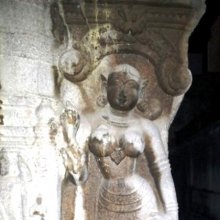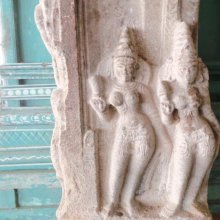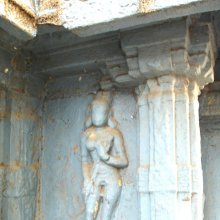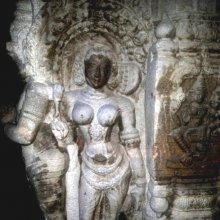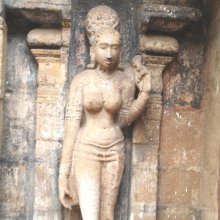Avahittha, Avahitthā: 11 definitions
Introduction:
Avahittha means something in Hinduism, Sanskrit. If you want to know the exact meaning, history, etymology or English translation of this term then check out the descriptions on this page. Add your comment or reference to a book if you want to contribute to this summary article.
Images (photo gallery)
(+22 more images available)
In Hinduism
Natyashastra (theatrics and dramaturgy)
Source: Wisdom Library: Nāṭya-śāstra1) Avahitthā (अवहित्था, “dissimulation”).—One of the thirty-three ‘transitory states’ (vyabhicāribhāva), according to the Nāṭyaśāstra chapter 7. These ‘transitory states’ accompany the ‘permanent state’ in co-operation.
2) Avahittha (अवहित्थ) refers to a gesture (āṅgika) made with ‘combined hands’ (saṃyuta), according to the Nāṭyaśāstra chapter 8. The hands (hasta) form a part of the human body which represents one of the six major limbs (aṅga) used in dramatic performance. With these limbs are made the various gestures (āṅgika), which form a part of the histrionic representation (abhinaya).
3) Avahittha (अवहित्थ) also refers to a type of posture (sthāna) for women (strī); defined in the Nāṭyaśāstra chapter 12. Accordingly, “The sthāna will be maintained by a dancer till any movement begins. For during a dance the sthāna is at an end when the cārī (‘dance-steps’) has begun. This is the rule of the sthāna for women and for men as well.”
Source: archive.org: The mirror of gesture (abhinaya-darpana)1) One of the saṃyutta-hastāni (Twenty-four combined Hands).—Avahittha (dissimulation): two Alapadma hands are held on the chest. Usage: erotic dances (śṛṅgāra-naṭana), holding a playball, the breasts.
2) One of the saṃyutta-hastāni (Twenty-six combined Hands).—Avahittha: Śukatuṇḍa hands held against the heart. The patron deity is Mārkaṇḍeya. Usage: debility, wasting of the body, eager interest, thinness.
Source: archive.org: Natya Shastra1) Avahitthā (अवहित्था, “dissimulation”) is the concealment of appearance. It is caused by determinants (vibhāva) such as shame, fear, defeat, respect, deceit and the like. It is to be represented on the stage by consequents (anubhāva) such as speaking like another person, looking downwards, break in the speech, feigned patience and the like.
2) Avahittha (अवहित्थ).—A type of gesture (āṅgika) made with combined hands (saṃyuta-hasta);—(Instructions): When the two Śukatuṇḍa hands meet each other on the breast and are bent and then slowly lowered, the Avahittha hands will be the result.
(Uses): It is to be used in indicating weakness, sigh, showing one’s body, thinness [or the body] and longing [for a beloved].
3) Avahittha (अवहित्थ).—A type of sthāna (posture) for women.—Instructions: The left foot will be Sama and the right (lit. the other at the side) foot Tryaśra (obliquely placed) and the left waist raised up.
(Uses): This Sthāna is known (lit. remembered) as natural for women during conversation [with anyone], in determination, satisfaction and conjecture. In representing anxiety, amorousness, sportiveness, grace, the Erotic and the like [Sentiments] and looking towards the way of someone [coming or going] this Sthāna is to be used.
Source: Shodhganga: Elements of Art and Architecture in the Trtiyakhanda of the Visnudharmottarapurana (natya)1) Avahittha (अवहित्थ) refers to one of the thirteen Saṃyuktahastas or “combined hand gestures” (in Indian Dramas), according to the Viṣṇudharmottarapurāṇa, an ancient Sanskrit text which (being encyclopedic in nature) deals with a variety of cultural topics such as arts, architecture, music, grammar and astronomy.—The hasta-mudrās (lit. “hand-gestures”) are very essential to denote some particular action or state in dancing and these mudrās are formed with the help of hands and fingers.—According to the Viṣṇudharmottarapurāṇa, in avahittha posture both hands are kept in śukatuṇḍa posture and placed on the chest. The head part of both hands should be bent gradually and downwards. This posture is used to denote weakness, fast breathing and showing the body parts.
2) Avahittha (अवहित्थ) also refers to one of the thirty Nṛttahastas or “dance hand gestures”.—In the Viṣṇudharmottarapurāṇa, thirty kinds of nṛttahastas (“dance-hand gestures”) are mentioned. e.g., avahittha. The practice of these nṛttahastas is strictly prohibited in sickness of body, in old age, in fear, drunk and anxiety.
3) Āvahittha (आवहित्थ) also refers to “one of the three kinds of standing postures for Women” (in Indian Dramas), according to the Viṣṇudharmottarapurāṇa.—Standing postures are determined separately for male and female. In the Viṣṇudharmottarapurāṇa three kinds of standing postures are discussed for women. The āvahittha posture is used to show erotic gestures.

Natyashastra (नाट्यशास्त्र, nāṭyaśāstra) refers to both the ancient Indian tradition (shastra) of performing arts, (natya—theatrics, drama, dance, music), as well as the name of a Sanskrit work dealing with these subjects. It also teaches the rules for composing Dramatic plays (nataka), construction and performance of Theater, and Poetic works (kavya).
Languages of India and abroad
Sanskrit dictionary
Source: DDSA: The practical Sanskrit-English dictionaryAvahitthā (अवहित्था) or Avahittha (अवहित्थ).—
1) Dissimulation in general.
2) Dissimulation or concealment of an internal feeling, regarded as one of the 33 subordinate feelings (vyabhicāribhāva); भयगौरवलज्जादेर्हर्षाद्याकारगुप्तिरवहित्था (bhayagauravalajjāderharṣādyākāraguptiravahitthā) S. D.; or according to R. G. व्रीडादिना निमित्तेन हर्षाद्यनुभावानां गोपनाय जनितो भावविशेषोऽवहित्थम् (vrīḍādinā nimittena harṣādyanubhāvānāṃ gopanāya janito bhāvaviśeṣo'vahittham); for ex. see Kumārasambhava 6.84, or Bv.2.8.
Derivable forms: , avahittham (अवहित्थम्).
See also (synonyms): abahitthā.
Source: Cologne Digital Sanskrit Dictionaries: Shabda-Sagara Sanskrit-English DictionaryAvahittha (अवहित्थ).—nf.
(-tthaṃ-tthā) Dissimulation. E. a neg. vahir outer, sthā to stand; an irregular form: what does not shew outwardly.
Source: Cologne Digital Sanskrit Dictionaries: Monier-Williams Sanskrit-English Dictionary1) Avahittha (अवहित्थ):—n. (corrupted [from] abahiḥ-stha?) dissimulation
2) Avahitthā (अवहित्था):—[from avahittha] f. idem, [Daśarūpa; Sāhitya-darpaṇa etc.]
Source: Cologne Digital Sanskrit Dictionaries: Yates Sanskrit-English DictionaryAvahittha (अवहित्थ):—[ava-hittha] (tthā-tthaṃ) 1. f. n. Dissimulation.
[Sanskrit to German]
Sanskrit, also spelled संस्कृतम् (saṃskṛtam), is an ancient language of India commonly seen as the grandmother of the Indo-European language family (even English!). Closely allied with Prakrit and Pali, Sanskrit is more exhaustive in both grammar and terms and has the most extensive collection of literature in the world, greatly surpassing its sister-languages Greek and Latin.
Kannada-English dictionary
Source: Alar: Kannada-English corpusAvahittha (ಅವಹಿತ್ಥ):—
1) [noun] the act of concealing one’s feelings, passion or emotion (often, as in or sentiment in poetic works, dancing etc.).
2) [noun] (dance) a hand gesture, holding both the in front of the breast, palms facing down, with fingers bent, but the central one being bent less than others.
Kannada is a Dravidian language (as opposed to the Indo-European language family) mainly spoken in the southwestern region of India.
See also (Relevant definitions)
Partial matches: Ava.
Starts with: Avahitthahasta, Avahitthaka.
Full-text: Avahitthaka, Ahittha, Vyabhicaribhava, Weakness, Fast breathing, Vyabhicarin, Abahittha, Samyutta-hastani, Samyuta, Showing, Nrittahasta, Pramada, Samyuktahasta, Avahitthahasta.
Relevant text
Search found 12 books and stories containing Avahittha, Avahitthā, Ava-hittha; (plurals include: Avahitthas, Avahitthās, hitthas). You can also click to the full overview containing English textual excerpts. Below are direct links for the most relevant articles:
Sahitya-kaumudi by Baladeva Vidyabhushana (by Gaurapada Dāsa)
Text 4.40 < [Chapter 4 - First-rate Poetry]
Text 4.98 < [Chapter 4 - First-rate Poetry]
Text 4.99 < [Chapter 4 - First-rate Poetry]
Gati in Theory and Practice (by Dr. Sujatha Mohan)
Gati performed in Nṛtta < [Chapter 3 - Application of gati in Dṛśya-kāvyas]
Relevant Sthānas and Nyāyas related to perform the Gati < [Chapter 2 - Concept and technique of Gati]
Description of Gati as in Viṣṇudharmottarapurāṇa < [Chapter 2 - Concept and technique of Gati]
Bhakti-rasamrta-sindhu (by Śrīla Rūpa Gosvāmī)
Verse 2.4.118 < [Part 4 - Transient Ecstatic Disturbances (vyābhicāri-bhāva)]
Verse 4.1.13 < [Part 1 - Laughing Ecstasy (hāsya-rasa)]
Verse 2.4.120 < [Part 4 - Transient Ecstatic Disturbances (vyābhicāri-bhāva)]
Vishnudharmottara Purana (Art and Architecture) (by Bhagyashree Sarma)
2.2. Hand Postures (b): Saṃyukta-hasta < [Chapter 3 - Drama and Dance]
2.2. Hand Postures (c): Nṛtta-hasta < [Chapter 3 - Drama and Dance]
Abhinaya-darpana (English) (by Ananda Coomaraswamy)
The Agni Purana (by N. Gangadharan)
